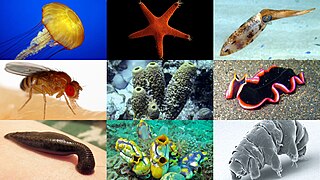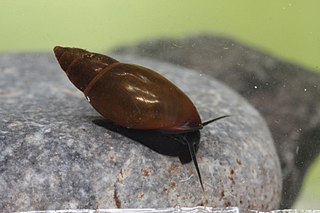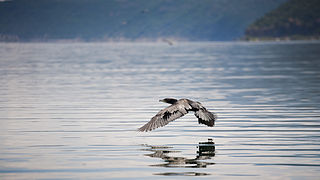Related Research Articles

Invertebrates is an umbrella term describing animals that neither develop nor retain a vertebral column, which evolved from the notochord. It is a paraphyletic grouping including all animals excluding the chordate subphylum Vertebrata, i.e. vertebrates. Well-known phyla of invertebrates include arthropods, mollusks, annelids, echinoderms, flatworms, cnidarians, and sponges.

Any worm that lives in a marine environment is considered a water worm. Marine worms are found in several different phyla, including the Platyhelminthes, Nematoda, Annelida, Chaetognatha, Hemichordata, and Phoronida. For a list of marine animals that have been called "sea worms", see sea worm.

The depressed river mussel or compressed river mussel, Pseudanodonta complanata, is a species of freshwater mussel, an aquatic bivalve mollusk in the family Unionidae, the river mussels. The species name comes from the flattened shape of its shell.

The duck mussel is a species of freshwater mussel in the family Unionidae, the river mussels.

Gyraulus crista, commonly called the Nautilus ramshorn, is a minute species of freshwater snail, an aquatic pulmonate gastropod mollusk in the family Planorbidae, the ram's horn snails.

Bithynia tentaculata, common names the mud bithynia or common bithynia, or faucet snail is a relatively small species of freshwater snail with gills and an operculum, an aquatic prosobranch gastropod mollusk in the family Bithyniidae.

Viviparus contectus, common name Lister's river snail, is a species of large, freshwater snail with an operculum and a gill, an aquatic gastropod mollusk in the family Viviparidae, the river snails.

Bithynia leachii is species of small freshwater snail with an operculum, an aquatic prosobranch gastropod mollusk in the family Bithyniidae.
Arion vejdorskyi or Arion vejdowskyi is a taxon with unclear taxonomic position and probably a synonym for other species. It was described as a species of air-breathing land slug, a shell-less terrestrial gastropod mollusk in the family Arionidae, the roundback slugs.

Viviparus viviparus is a species of large freshwater snail with a gill and an operculum, an aquatic gastropod mollusk in the family Viviparidae, the river snails. This species is a viviparous (ovoviviparous) snail.

Acroloxus lacustris, or the lake limpet, is a small freshwater limpet or snail, a species of aquatic gastropod mollusk in the family Acroloxidae.

Aplexa hypnorum, or by the common name, the moss bladder snail, is a species of small air-breathing freshwater snail, an aquatic pulmonate gastropod mollusk in the family Physidae, a family which are sometimes known as the bladder snails.

Physa fontinalis, common name the common bladder snail, is a species of air-breathing freshwater snail, an aquatic gastropod mollusc in the family Physidae. The shells of species in the genus Physa are left-handed or sinistral.

Alzoniella slovenica is a species of very small or minute freshwater snail with an operculum, an aquatic gastropod mollusk in the family Hydrobiidae, which are sometimes known as the snouted water snails.

Worms are many different distantly related bilateral animals that typically have a long cylindrical tube-like body, no limbs, and usually no eyes.
The Clare Island Survey was a multidisciplinary survey of Clare Island, off the west coast of Ireland.
The biological systematics and taxonomy of invertebrates as proposed by Richard C. Brusca and Gary J. Brusca in 2003 is a system of classification of invertebrates, as a way to classify animals without backbones.

The annelids, also known as the segmented worms, comprise a large phylum called Annelida. It contains over 22,000 extant species, including ragworms, earthworms, and leeches. The species exist in and have adapted to various ecologies – some in marine environments as distinct as tidal zones and hydrothermal vents, others in fresh water, and yet others in moist terrestrial environments.

The wildlife of Finland is affected by prevailing environmental conditions. The phytogeography of Finland is shared between the Arctic, central European, and northern European provinces of the Circumboreal Region within the Boreal Kingdom. The territory of Finland can be subdivided into three ecoregions: the Scandinavian and Russian taiga, Sarmatic mixed forests, and Scandinavian montane birch forest and grasslands. Taiga covers most of Finland from northern regions of southern provinces to the north of Lapland. On the southwestern coast, south of the Helsinki-Rauma line, forests are mixed as is more typical in the Baltic region. In the extreme north of Finland, near the tree line and Arctic Ocean, montane birch forests are common.

Over 22,500 species of wildlife have been recorded in North Macedonia. Over 10,000 of these are insects, which include 3,000 beetle species and large numbers of Lepidoptera, flies, and Hymenoptera. Aside from insects, other large arthropod groups include Chelicerata and crustaceans. Among vertebrates, more than 300 species of birds recorded, although not all nest in the country. There are over 80 species of both fish and mammals, 32 reptiles, and 14 amphibians.
References
- ↑ "Czech Republic - Land". Encyclopedia Britannica. Retrieved 2021-08-09.
- Optarný E. (1999) Zoogeografie. - Univerzita Palackého v Olomouci, Olomouc, 191 pp., ISBN 80-244-0011-1 (in Czech)